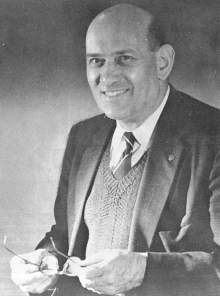
Paul Voigt was born in London on the 9th December 1901. His German parents had become naturalised British citizens after immigrating to England in the late 1800's. After studying at Dulwich College, he gained a Bachelor of Science

His first employment was with J. E. Hough Ltd at the Edison-Bell works, London in 1922. J. E. Hough wanted to expand into the growing wireless market, and Paul Voigt was employed for his specialised knowledge in that area. Voigt developed several new products, including a slack diapragm condenser microphone, a high flux energised speaker drive unit and horns using the "tractrix" contour.
By 1926 he had developed the first British electric recording system. Under a mutual agreement, all these Edison Bell products were protected by patents taken out by Paul Voigt himself. In 1933 due to a slump in economy, Edison Bell ceased trading. Shortly after the demise of J. E. Hough, Voigt set up his own company "Voigt Patents" based in Sydenham, London.
The "Domestic Corner Horn" released in 1934 set a new benchmark for high quality sound reproduction. This unique design gave an extremely life-like non-directional presentation, with the sound entering the room at a height between 3 - 5 feet from the floor. Also in 1934 Paul Voigt met O. P. Lowther from the Lowther Manufacturing Company Ltd., and a strong friendship was formed. During the following years an alliance between the two companies was formed, both having the aim to produce the finest sound reproducing sound available. During 1936 a Lowther sales brochure entitled "Lowther-Voigt Radio" was released. Details of three radiograms, separate amplifiers, tuners and loudspeakers were described, giving many different options for domestic use including custom-building into individual furniture cabinets. The most ambitious radiogram listed was the model "A/V", which was supplied with a 12-watt amplifier and separate deluxe Voigt domestic corner horn loudspeaker. This model was aimed at the luxury end of the market and sold for £150-0s-0d.
With the outbreak of World War Two in 1939 sales of high-quality sound equipment fell sharply. Voigt was kept busy during the war maintaining his horn speakers installed in cinemas. After the war, with the introduction of many new magnetic materials, the design of a permanent magnet drive unit was given priority. This new permanent magnet drive unit, having a flux density of 18,000 Gauss (1.8 tesla) was released in 1949, at a cost of £40-0s-0d.
Due to a combination of ill health, rationing of raw materials, high purchase tax, and slow sales figures, he decided to move to Canada with his wife in April 1950. Paul Voigt died on 9th February 1981, leaving a legacy of so many advancements in the pursuit of perfect sound quality.
After the war, Donald Chave who previously was Lowther's chief engineer, had now bought the company. Donald Chave had also been working on designing a permanent magnet drive unit, culminating in the PM1. This drive unit utilised a Voigt cone assembly and sold for £32-0s-0d. Before Paul Voigt left for Canada an agreement for Lowther to produce the Domestic Corner Horn loudspeakers under licence had been agreed. A total of approximately 400 domestic corner horns were manufactured between 1934 and the early 1950's.
Donald Chave gradually expanded the range of amplifiers, tuners, loudspeakers and drive units available, all products being hand-made. Many new models of drive units, horn loudspeakers and valve amplifiers made their debut over several years, building on the design principles laid down by Paul Voigt. Possibly the most famous "classics" of these being the PM6, PM2 and PM4 drive units, the TP1 and Acousta loudspeakers, and the LL26 valve amplifier. Donald Chave carried on the tradition of producing high quality products until his death.
Today Lowther are still producing high quality full-range drive units and loudspeakers which are exported all over the world. Their website is www.lowtherloudspeakers.co.uk.
This website is dedicated to Paul Voigt, O. P. Lowther, Donald Chave and John Wilkinson. Without meeting John Wilkinson and hearing his system with four domestic corner horns, I would never have become a Voigt enthusiast and collector.